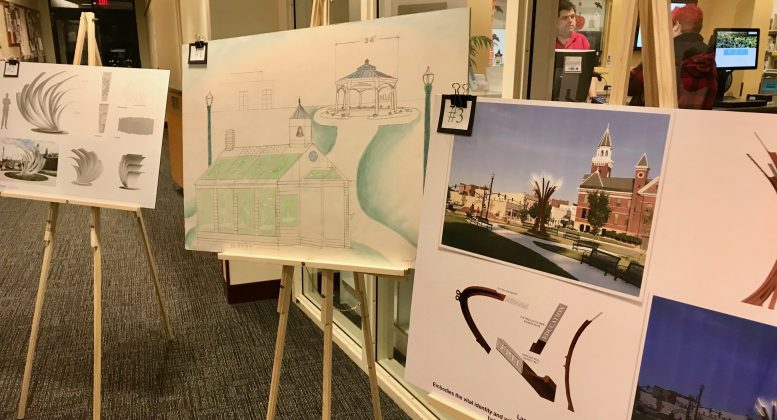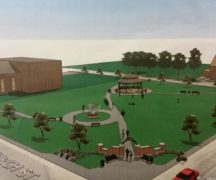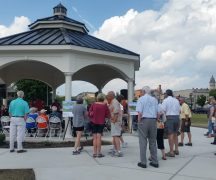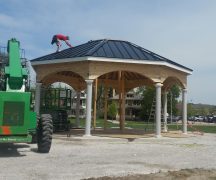By DAVID DUPONT
BG Independent News
Three artists presented their concepts for what will be the finishing touch for Wooster Green.
Mayor Dick Edwards said with the gazebo, water fountain, irrigation, and archway in place, the green space now needs “the all-important public arts project.”
The steering committee charged with finding and approving the artwork hosted public presentations by the three finalists Wednesday (Oct. 23).
Presenting were:
They were selected from more than 20 initial proposals. The committee has a $45,000 budget.
The artists were given several themes that the steering committee wanted the work to reflect — history, industry, faith, education, and community.
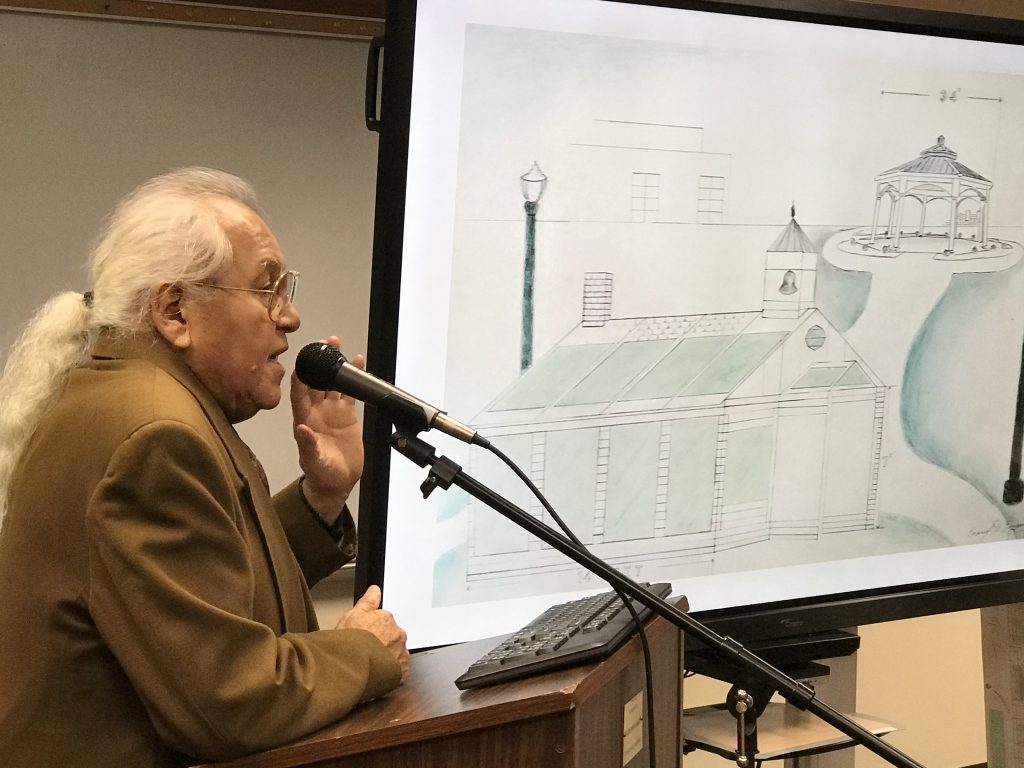
Enriquez began with a retrospective of his work. A Pemberville native, he has work on display on the campus of Bowling Green State University, from which he has two art degrees, Schedel Gardens, and Fifth Third Field among other notable sites in the region.
For the Wooster Green proposal he drew his inspiration from near and far, including the Louvre and Notre Dame renovations in France to a playhouse he helped build in the backyard of his assistant, Kathleen Pahl.
Enriquez proposes installing a small school constructed with half-inch thick green-tinted glass panels. The structure will be seven feet tall inside with doors on either end, so people can enter. He will etch imagery from the area on the panels inside. Those could include an image of the county courthouse, the old windmill on Clough Street, and University Hall, as well as images evoking the seasons. Musical notes from Antonio Vivaldi’s “The Seasons” will also be included. The ceiling would be decorated with the constellations.
The building will have a footprint of 14 by 10 feet the cupola will be 13-14 feet tall.
Enriquez said he wanted people to be able to enter “and enjoy the nostalgia of an old-time schoolhouse.”
He is undecided about what the framework supporting the glass will be. “That could be decided by the committee,” he said. “My objective is to do nice work on the etching of the glass.”

Kistler started her career as a designer of interactive exhibits for children’s museums.
She said she started by thinking about the former use of the site, which included the manse for the neighboring Presbyterian Church. That a school long stood there, and that the school had a library, made the deepest impression on her.
“I landed on the concept of moving pages of the book,” she said. “A book really says education, says library, says community history.”
Each of the 13 pages would be made of 3/16th-of-an-inch thick unfinished stainless steel plates with each page welded to previous page. The width at the base would be 14 feet with a height of 10.5 feet.
The lip of the lowest page should be tall enough to discourage anyone from swinging on it.
Each page would have images and text laser cut into them. She uses a half-tone technique that allows her to take photographs, simplify them and then cut them into the steel.
Those images would “speak to the history of the site.”
She showed a couple “placeholder images.” One had a stain glass design reflecting its use by the nearby church. But the actual content would be determined if she was commissioned to do the project.
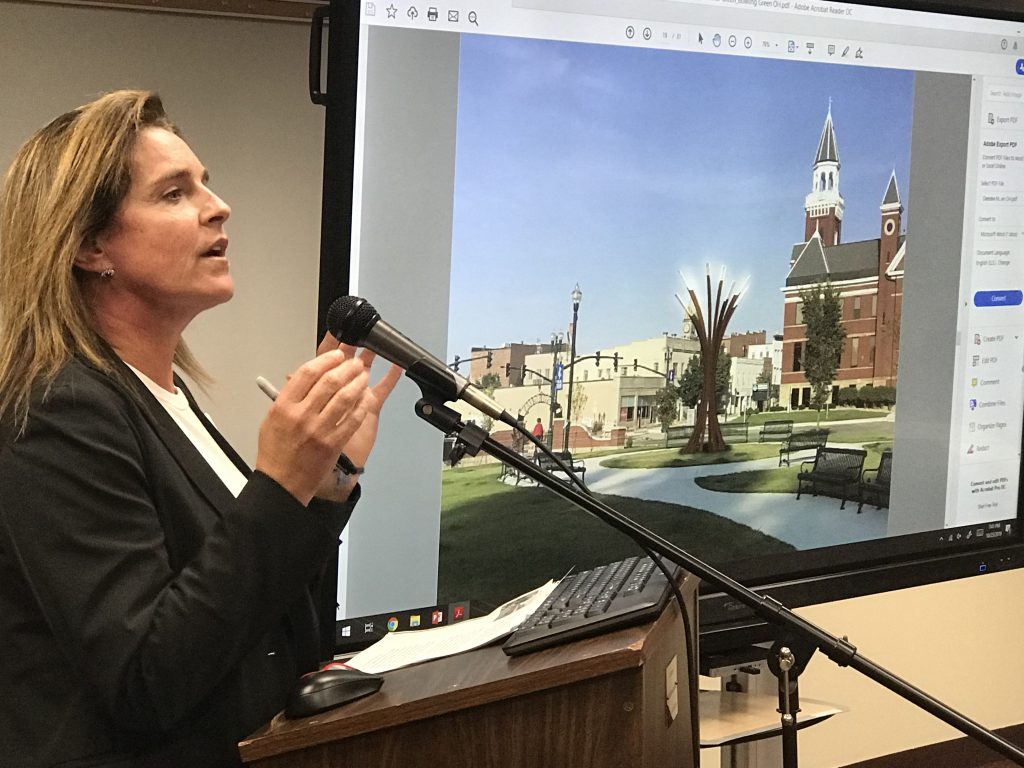
Morrison said that creating public art is “all about storytelling,” and her story of Bowling Green starts 10,000 years ago when the glaciers retreated, and left an expansive wetland 30 miles wide and 100 miles long. “This is an anchoring part of what creates Bowling Green.”
Morrison tells her visual story using eight rising, bent pillars. Each represents one of the five themes required by the steering committee, plus three she added —geology, environment, and agriculture. As a tribute to the railroad that made the development of the city possible, she plans to use vintage rails, for which she has located a source.
On top of each she will place stainless steel with the words representing those themes laser cut into them.
She will then illuminate those words with LED lights that will be programmed to change colors. These “choreographed” lights would add another dimension to the sculpture at night, she said.
Each of the pillars will be a different height, with the tallest rising 17 feet.
John Calderonello, of the Bowling Green Arts Council, noted that the words at the top of the pillars were “extremely general” and could apply to just about any community.
Morrison that if she were awarded the commission she could work with community members to come up with words that more specifically tell the story of Bowling Green.
Those present could express their preference and explain their choice on ballots that are being collected.
Posters showing each of the designs and ballots and ballot box will be on display at the Wood County District Public Library through Oct. 30.
Diane Vogtsberger, a member of the steering committee, said that the panel will meet that day, and decide on awarding the commission.
The voting, she said, is really meant as one input with the steering committee making the final decision.
The plan is to install the work in June.

